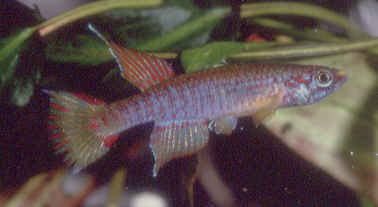Aphyosemion thysi Radda & Huber 1978

A.thysi RPC 9 circulating in the US around 1980. Photo: Courtesy of Lennie MacKowiak
Aphyosemion thysi Radda & Huber 1978

A.thysi RPC 9 circulating in the US around 1980. Photo: Courtesy of Lennie MacKowiak
| Meaning of Name |
After Prof. Dr. Ir. Dirk Thys van den Audenaerde, a Belgian ichthyologist & director of the Musée Royale de l'Afrique Centrale, Tervuren. |
||||||
| First Description |
Radda A.C. & Huber J.H. 1978. Die Rivulinen des südlichen Kongo (Brazzaville) I, Beschreibung von vier neuen Arten der Gattung Aphyosemion Myers. Aquaria 25: p 173-175, figure 1-2. |
||||||
| Size |
5 cm |
||||||
| Meristics |
D = 11-12, A = 14-15, D/A = +7-8, ll = 29-30 (+1-2) (Radda & Huber 1978) |
||||||
| Karyotype |
n = 14, A = 26 (Scheel 1981) |
||||||
| Sub-Genus |
Mesoaphyosemion |
||||||
| Group |
thysi (given as ogoense in 'Killies of the World' Vol I (Wildekamp) although this was noted as the opinion of Radda & Huber. Wildekamp considered them to be closely related to A.schluppi. In view of the similarity of finnage & general shape I would agree with this. Also, both species are found in close proximity. |
||||||
| Synonyms |
None |
||||||
Populations
|
CMBB89 / 12 |
||||||
| Type Locality |
500 m from Ngala, on the Titi - Mossendjo road, Niari Province, Louessé River drainage system, southern Congo. |
||||||
| Distribution |
The area of Mossendjo - Komono in the Louessé - Niari River drainage system. |
||||||
| Habitat |
Hilly rainforest & tree grassland brooks/small streams. Sympatric sp. include A.schluppi, A.wachtersi & A.buytaerti. |
||||||
| Distinguishing Characteristics | Anal & dorsal fins are pointed much the same as A.schluppi. A.thysi is not a very colourful species, lacking bright colouration. The upper caudal fin can have a larger extension than the lower. | ||||||
| Colour/Pattern Variability | Medium | ||||||
| History |
Discovered by Buytaert & Wachters on the
14th July 1978 at 1030 hrs at collection point RPC 6. Also collected
from points RPC 7, 9, 20 & 22. Imported to the UK & distributed by BKA Species Import Committee July/August 1979. This location was RPC 22. |
||||||
| Breeding Notes |
Regarded as a more difficult species. I bred
the RPC 9 population in the early 1980's & raised on about 3 pairs.
Most eggs were laid in top mops but the odd one was found on bottom
mops but were not prolific. At the time I used hard water DH 10, pH
7-8 temperature 73-75°F. I would use rainwater for future attempts
which would probably give better results. Water incubation is around
14 days but I have seen reports which suggest they can hatch in 10 days..
Newly hatched fry are a good size but I used infusoria which was always
in the tank for the first week graduating onto micro worm & newly
hatched brine shrimp. Also, they are sensitive to velvet so the tank
must be kept clean at all times. Sexual maturity is slow in coming at
around 8 months. |
||||||
| Diameter of Egg | Fairly large. | ||||||
| Remarks |
The male I received seemed quite thin & required 3 months of heavy feeding on white worm & other live foods to get some body on him. Many photos I have seen of males also show a thin body. I'm not sure why this should be. |